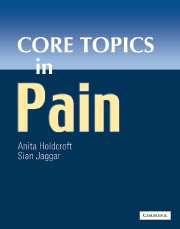Book contents
- Frontmatter
- Contents
- Contributors
- Preface
- Acknowledgements
- Foreword
- General abbreviations
- Basic science abbreviations
- PART 1 BASIC SCIENCE
- PART 2 PAIN ASSESSMENT
- Section 2a Pain measurement
- 9 Measurement of pain in animals
- 10 Pain measurement in humans
- Section 2b Diagnostic strategies
- PART 3 PAIN IN THE CLINICAL SETTING
- Section 3a Clinical presentations
- Section 3b Pain syndromes
- PART 4 THE ROLE OF EVIDENCE IN PAIN MANAGEMENT
- PART 5 TREATMENT OF PAIN
- Section 5a General Principles
- Section 5b Physical treatments
- Section 5c Pharmacology
- Section 5d Psychosocial
- PART 6 SUMMARIES
- Glossary
- Index
9 - Measurement of pain in animals
from Section 2a - Pain measurement
Published online by Cambridge University Press: 10 December 2009
- Frontmatter
- Contents
- Contributors
- Preface
- Acknowledgements
- Foreword
- General abbreviations
- Basic science abbreviations
- PART 1 BASIC SCIENCE
- PART 2 PAIN ASSESSMENT
- Section 2a Pain measurement
- 9 Measurement of pain in animals
- 10 Pain measurement in humans
- Section 2b Diagnostic strategies
- PART 3 PAIN IN THE CLINICAL SETTING
- Section 3a Clinical presentations
- Section 3b Pain syndromes
- PART 4 THE ROLE OF EVIDENCE IN PAIN MANAGEMENT
- PART 5 TREATMENT OF PAIN
- Section 5a General Principles
- Section 5b Physical treatments
- Section 5c Pharmacology
- Section 5d Psychosocial
- PART 6 SUMMARIES
- Glossary
- Index
Summary
Introduction
At the turn of the last century, Sir Charles Sherrington established many of the fundamental concepts regarding how mammals respond to noxious stimuli. He proposed that specialized cells, which he termed nociceptors (from the Greek nocere, meaning ‘to harm’), serve to alert the animal to situations where real or potential tissue damage may occur. Pain or ‘nociception’ as Sherrington referred to it, is a sensory experience that triggers a type of ‘alarm system’ in the animal. This sensory ‘alarm system’ can then initiate the appropriate motor output programmes that will remove the animal away from the threat. In higher vertebrates, and especially humans, the sensation of pain can often involve far more complex processes than a simple, stimulus—response reflex arc. In this case, higher cognitive functions, such as attentional state, emotion and memory are also considered critical factors in the perception of pain.
This complexity requires that many lines of scientific investigation be pursued. Reductionist approaches alone will be insufficient if advances in the development of new therapeutic strategies for pain are to be made. A mechanistic approach demands that careful study of complex animal systems at the behavioural level be carried out. Thus we will summarize:
Fundamental principles.
Common behavioural assays.
Basic concepts of experimental design (referring to rodents unless otherwise stated).
- Type
- Chapter
- Information
- Core Topics in Pain , pp. 67 - 70Publisher: Cambridge University PressPrint publication year: 2005



